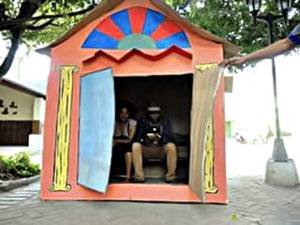Puente Sur: Art Performances and Installations Outside Havana
Yanelys Nuñez Leyva

HAVANA TIMES — I. We were carrying a two-meter-tall, cardboard house. We only had a few blocks to walk to reach Esquina de Tejas, where the bus would pick us up. It was the opening day of the Puente Sur National Performance and Installation Day. Finally, the monotony of my days had been interrupted by something new, and what better something than an art exhibition.
We gestured at the small Giron bus, thinking the rudimentary house, a work by Luis Manuel Otero, would not fit inside the vehicle. But it did. Marcel, Yonlay, Alejandro and Larianni helped me squeeze it past the narrow door.
Luckily for the house, there were few people aboard. Apparently, the other participants were heading to the venue through their own means.
Puente Sur, which is already turning 16, an exhibition that has toured different venues in the province of Mayabeque, sponsored by the Hermanos Saiz Association, returned to its venue in San Jose de las Lajas this year.
II.
We arrived at the San Jose Young Artists Center. There, they welcomed us handing us credentials and the program.
I unpacked the house we had planned to set up on the pedestrian boulevard, where the Wi-Fi hotspot operates. The house was designed as an alternative dwelling allowing users to connect to the web with a certain degree of privacy, but it was still missing a number of finishing details. We decided to set up the installation the following day.

We began to stroll around town.
We went to the theater, where we found a selection of the best of visual art in Mayabeque, including an abundance of pictorial works.
Aluan Arguelles got to work. He followed different people on the street with his camera, spy-like. He lost one of his subjects when the guy began to suspect something and hid from view. As the day advanced, we would see how he’d complete the piece.
Yulier P. asked permission to spray-paint a graffiti on the side of a house. The owner agreed, initially, but, when she realized the images were “devilish,” she asked him not to, invoking her Catholic upbringing. He had better luck at a different house. There, some of his monsters came alive again.
Yoanny Aldaya, a formally-trained and devoted photographer, went beyond the boundaries of his discipline and carried out his first performance. A bit nervous, he ate a hamburger while flogging himself with a US flag in the middle of the pedestrian boulevard.
Onlookers cast surprised looks at him and some asked him why he did this when the performance was over.
III.
On Friday, we set up the house. The children loved it, played inside it. Some people, like myself, connected to the Internet. The prototype worked! The Wi-Fi signal came into the house, through the windows, without any problems.
That same day, we were finally able to have a good laugh with some chapters of the “Collector of Ridiculous Facts,” a YouTube show by Ranfis Suarez, projected on the big screen of the San Jose theater. It was great. Good audio, good image quality. We only needed more of an audience. This was an experience that needs to be repeated.
IV.

Saturday afternoon, the general curator of Puente Sur, Yonlay Cabrera, joined Aluan Arguellas to work out the details of the presentation of the latter’s work. They headed out in search of the bicycle taxi that, equipped with a good sound system, would play audio explaining everything having to do with Visitante version 00.02.
As the three-wheeled vehicle went around the area, some of the pictures taken by Arguelles, anonymously and watchfully, were projected onto buildings.
These were some of the pieces I was able to see and be a part of, getting to know a different space for artistic endeavors outside of Havana, the cultural center.
It’s a shame only a handful of artists participated because of the little publicity the event has and the scant resources devoted to it. Perhaps, under the guidance of a good administrator like Yonlay, Puente Sur could grow.





